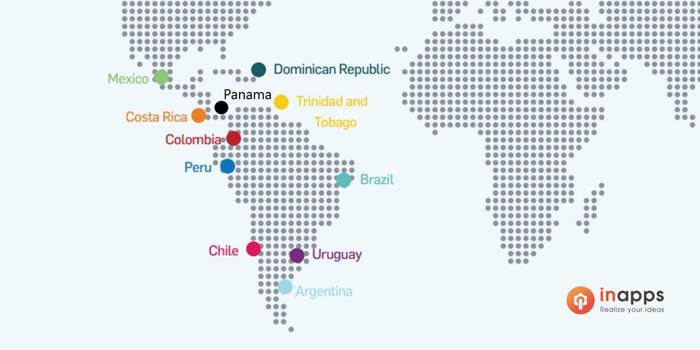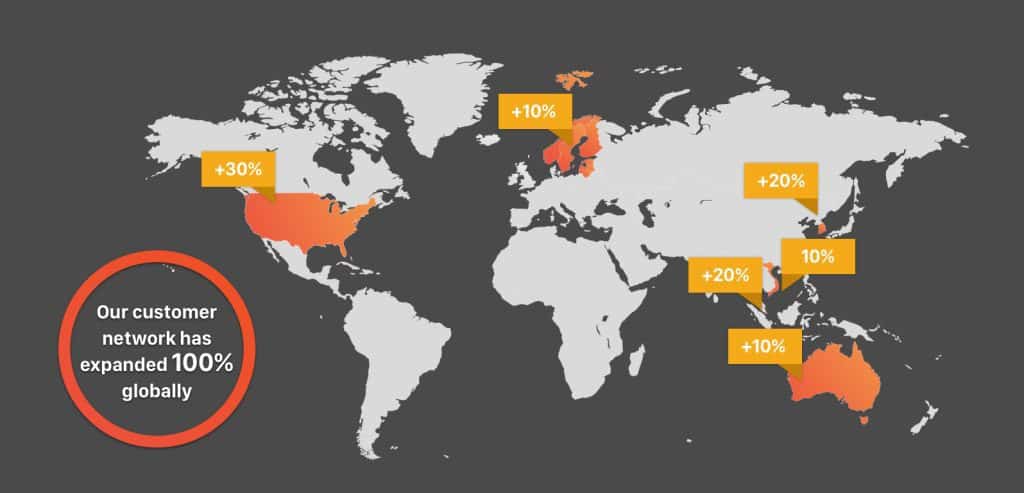4 things to consider when hiring Software Developers from LatAm.
Covid-19 accelerated investment in the technology industry, especially in the VC and Private Equity sectors, which led to VCs surpassing the $100 billion threshold in fundraising during 2021, with average fund sizes higher than ever at close to $195 million.
The pandemic also opened the eyes of many companies to the remote world: they realized that their sudden shortage of qualified developers, engineers, designers, and other technical talents could very well be supplied by nearby countries. And we’re talking about top-tier engineering jobs, not just repetitive low-complexity roles.
This trend has allowed companies to fulfill their technical talent needs even faster than in a pre-pandemic world. However, because of the general surge in demand for tech talent worldwide, and specifically in the US, companies have had to switch up their hiring strategies.
Latin America offers largely untapped markets of culturally diverse and English-speaking talent with general knowledge of American culture. Like US talent, these professionals bring industry expertise and know-how while also offering fresh perspectives and out-of-the-box thinking.
LatAm has opened up a pipeline to a sizable talent pool with equal or fairly similar time zone perks, quickly leading to a gap between supply and demand for tech talent. Companies can still attract top-tier talent with the proper benefits and compensation.
Nearshoring to a different country requires understanding different peculiarities your company may face throughout the process. This entails everything from cultural differences to payment and interviewing processes, depending on the countries you’re looking to hire.
So, here’s a list of things to keep in mind if you outsource software developers from LatAm.

4 things to consider when hiring Software Developers from LatAm
Cultural differences
To attract and hire technical talent in Latin America, it is essential to accommodate your hiring strategies to the cultural differences in the region. Here are the key differences when hiring locally in the US versus hiring remotely in LatAm:
-
Knowledge about local companies and universities
The tech landscape isn’t an easy one to navigate with limited familiarity with the region. As a foreign company, having knowledge of and understanding which schools have the best engineering programs can be tough. Contrary-wise, when looking for talent in the US, you probably find it easy and simple to understand the landscape.
According to QS’ Univeristy Rankings, the best Latin American tech schools include Universidade de São Paulo, Universidad Nacional Autónoma de México, Universidad Estadual de Campinas, Pontificia Universidad Católica de Chile, Universidad de Chile, Universidad Tecnológica Nacional, Instituto Politécnico Nacional, Instituto Tecnológico y de Estudios Superiores de Monterrey, and Universidad Nacional de Colombia. But these are just the most prominent ones, there are many other excellent institutes and universities out there in Latin America.
Nevertheless, if you find a candidate among graduates from these universities, you can be ensured that they have a great technical education.

-
Differences in engineering backgrounds
As different opportunities are available and accessible to engineers from both regions, the career path of a LatAm engineer is quite different from that taken by tech talent in the US.
Latin America’s talent pool comprises formal university degrees, boot camps, and coding academies, followed by a mix of corporate jobs in outsourcing and tech firms and many varied experiences acquired by freelance work.
This non-traditional path typically generates an entrepreneurial mindset in the talent, ultimately benefiting the company they end up working for.
Whether interviewing in LatAm or the US, you should always remember a few best practices that will help you run an efficient and smooth hiring process. Since you are hiring a team member, a rigorous interview process must be carried out.
When interviewing talent from Latin America, you should go through resumes thoroughly. Latin resumes are usually very modest: as a culture, they tend to lean towards teamwork and collectivism, so the candidate’s resumes won’t necessarily feature or highlight personal achievements.
Another factor to keep in mind is that the term used to refer to a resume is a CV, not a resume. Moreover, LatAm developers’ resumes tend to include personal photographs and a lot of personal information. They also tend to be much longer than the common single-page resume in the US.
Interviewing styles
It is important to take the time to design a process that accommodates cultural differences since interviewing styles tend to vary between regions. Here are a few tips to consider before beginning your interviewing process with a developer from Latin America:
-
Be upfront and transparent about the process
When interviewing, it’s key to be completely clear on what you’re looking to hire. You should give the interviewee details about your recruiting process and its assessment stages.
Even though interviewing styles vary in each company, most Latin American workers aren’t used to the typical multiple-stage interview process from most US companies, which consists of an initial screening, role-specific assignments, followed by one or two more interviews.
In contrast, LatAm interviews tend to include an initial, long-format interview, which can last anywhere between half an hour to an hour and a half, followed by one more interview, or two more interviews at the very most. However, common practices vary a lot depending on the country.
In short, letting the candidate know what your process is like will give them a clear view of what to expect from interviewing at your company.

-
Begin your interview by breaking the ice
Questions that are typically asked in US interviews, such as “which projects are you most proud of?” and “tell me a little about yourself,” are less common in Latina America, so they might make the candidate feel self-conscious.
To relieve the candidate’s stress, it is crucial to think of ways to make the interview environment a relaxed and open space. Plus, interviews are a two-way street: you need to sell your company to the candidate as much as they need to be selected for the job.
Consider beginning your interviews with personal questions so the candidate can warm up and you can start getting a sense of how they communicate. Some personal questions you could ask include:
- What are your hobbies and what do you enjoy doing in your free time?
- How do you handle being under pressure?
- What type of remote working environment are you looking for?
- Tell me about a time when you made a mistake and how you resolved it.
- What was your favorite project you’ve worked on so far?
- What type of technical challenges have you faced, and how did you manage to overcome them?
- Finally, after you’ve run through each of the applicant’s information and held all the interviews, decide how to strategically present your job offer, keeping in mind the benefits and salary expectations of the interviewee.
Invoicing and payments
Compensating remote LatAm contractors consists of two processes: invoicing and payment. Every month, the independent contractor or a company they work for sends you an invoice detailing the type of work they did and the number of hours they spent working.
As the employer, you have to check that all the information is correct and then make the payment.
Independent contractors tend to be tasked to keep a detailed account of their work hours. Every month, you should receive an invoice that goes into detail about the hours they spent working, the type of work they’ve done, and the amount of money they will get paid.
They should add as many details as possible. There are many tools with which the talent can make and send the invoice reports, such as:
- Invoicely
- Xero
- Freshbooks
- Scoro
- Inoice2Go
- QuickBooks
- Zoho Books
Once you receive their invoice reports, you should check that all the details are correct and that there isn’t any missing data.

The payment method that is the most popular is bank transfers. However, you should keep in mind that this method may not be the most beneficial for the recipient if they don’t have a bank account in the US.
But don’t worry, there are many alternatives you can offer the workers that allow money transfer overseas, including:
- Paypal: This is the most popular payment platform. Creating and maintaining an account is very simple, which is why it’s the usual go-to platform. Among its advantages, it allows contractors to generate their invoices and send them over to the employer within the platform. Once the employer reviews the invoice, they can send the payment, and the contractor will receive it almost instantly.
- Payoneer: This platform is very similar to PayPal and is widely used. It’s used in over 200 countries. Additionally, it offers lower transaction fees than PayPal, and it has fewer operational costs.
- Wise: This platform offers low transfer costs, convenient conversion fees, low rates, and, in many countries, instant transfers. Wise has many different useful tools, such as allowing you to pay contractors in different currencies.
- Cryptocurrency: While crypto isn’t currently the most used currency to pay contractors, many prefer this payment method. Some of the preferred coins are Bitcoin, USDT, and Ethereum. They are easy to use, fast, secure, and allow the contractors to easily access their money.
Suppose you don’t want to deal with the fuss of the invoices and the payments. In that case, another alternative is hiring an Employer of Record, which is a third-party company that will take care of all the employment tasks, including payroll, benefits, taxes, and the legal aspects of hiring remotely form the US.
Remote work contracts

You’ll probably have to create a work contract agreement for the people you hire. Even though these contracts tend to vary in each company, they should at least contain the following information:
- Work arrangement: The type of work that is going to get done, deliverables, key metrics with which you will measure the employee’s performance, the arranged work hours, etc.
- The compensation and benefits package that both parties already agreed upon beforehand.
- The equipment and services that the remote worker will need to fulfill their job, such as a high functioning computer, internet connection, and access (this point mostly refer to inhouse-hiring).
- Duration of the contract: while some companies choose to hire long-term, some still prefer hiring on a per-project basis with contracts that end when the project is successfully completed. So each contract should specify whether it is long-term or short-term.
- Exit plan: you should discuss this stage at the beginning to avoid any issues when finishing the project. How will the developers transfer their code and knowledge when your collaboration is over or when you want to change the development team.
Another important aspect of expanding your engineering teams to Latin America is to make sure your independent contractors file all the right tax documentation that applies to the local laws of your company through forms such as W-8BEN or W-8BEN-E.
These are used to inform the US government about the work that independent contractors are doing outside of the country.
Moreover, you should know that each country in the region has its own visa and tax regulations. Even though filing their own taxes and the correct local government forms is the responsibility of each worker, you should do a little bit of research to know what these regulations are in each of the countries in which you’re looking to hire, just to keep yourself informed.
Conclusion

The tech talent demand in Latin America keeps growing at a fast and steady pace, which is evident in the number of companies and organizations that are investing in the region.
Now, with remote and hybrid teams being the new normal, many companies are unveiling the true potential of hiring remotely, and LatAm countries with their pool of quality software developers are a great opportunity for all the US companies that face the developer shortage now.
Learn about the peculiarities of interviewing and hiring process we’ve mentioned in this article, and hire the top-level software engineers from LatAm.
Have you ever thought about outsourcing to Asia?
Asia is the ‘tiger’ in the software outsourcing industry, and India remains the best spot regarding scale and accessibility of abilities. Besides, China, the Philippines, and Vietnam also stand out in software outsourcing to Asia.
InApps is the Top software development company in Vietnam. We build dedicated teams enabling clients across the globe to leverage top-notch technologies delivered by experienced software engineers. The InApps service model covers:
- Build a dedicated team of back-end and front-end developers, designers, and project managers who will handle the full cycle of product development.
- Hire remote developers who can bring additional expertise and fresh perspective to your internal software development team.
- Open your own offshore development center and enjoy working with top-notch professionals who share your corporate values.
Our recruitment specialists have extensive market knowledge to meet the needs of businesses of different sizes. If you want to grow your startup with brilliant tech experts, InApps is the perfect partner for you.

List of Keywords users find our article on Google
[sociallocker id=”2721″]
| zoho invoice |
| hire latin american developers |
| software developers in latin america |
| hire developers in latin america |
| xero developer |
| freshbooks developer |
| zoho books vs quickbooks |
| fintech boot camp near me |
| zoho books vs xero |
| saas recruitment process outsourcing |
| freshbooks jobs |
| zoho invoice review |
| xero degrees |
| paypal interview questions |
| payoneer founder |
| zoho books review |
| wawa jobs near me |
| freshbooks career |
| zoho books vs quickbooks online |
| freelance qs jobs |
| quickbooks commerce alternative |
| zoho invoice reviews |
| latam developers |
| zoho projects alternatives |
| invoicely reviews |
| compare zoho books and xero |
| payoneer jobs |
| payoneer career |
| freshbooks blog |
| hire paypal developers |
| scoro review |
| contract offshore jobs |
| zoho people alternatives |
| paypal commerce platform reviews |
| web developer resumes |
| pool service software quickbooks |
| wise payoneer |
| zoho books reviews |
| wawa employee reviews |
| outsource technical interview |
| legal project pool software |
| xero degrees near me |
| paypal software engineer salary |
| wawa hiring |
| aspect software wiki |
| interview questions for lettings consultant |
| xero partner consultant |
| freshbooks salary |
| interview questions for contracts manager |
| fresh market interview questions |
| ريموت بايونير |
| professional overseas contractors |
| aspect software jobs |
| xero interview |
| chat with payoneer |
| scoro reviews |
| zoho invoice vs freshbooks |
| scoro alternatives |
| payoneer colombia |
| zoho ats pricing |
| zoho books |
| contracts manager interview questions |
| quickbooks trustpilot |
| hire xero developers |
| zoho invoicing |
| bank of america hiring process |
| xero custom invoice templates |
| hire box developers |
| teamwork projects vs zoho projects |
| hire computer vision developers |
| hire remote ethereum developers |
| scoro alternative |
| bank of america software developer jobs |
| hire zoho consultant |
| freelance tier 2 visa |
| quickbooks developer |
| zoho contracts |
| bank of america interview questions |
| universidad de chile jobs |
| devops engineer resume template |
| zoho books alternatives |
| latin america software developers |
| talent invoice template |
| ui developer resume |
| xero custom invoice template fields |
| quickbooks self employed invoices |
| flatform boot |
| paypal hiring |
| qa resumes |
| how to add bank details to xero invoice |
| freshbooks connector |
| hire freelance net developer |
| software development companies in us |
| hire a developer in latin america |
| wawa near me hiring |
| regions bank wikipedia |
| payoneer.com linkedin |
| paypal software engineer interview |
| things to do in campinas |
| connect facebook leads to scoro |
| game design wikipedia |
| xero interview questions |
| paypal jobs remote |
| zoho developer salary |
| paypal product manager interview |
| two way switch wikipedia |
| paypal coding interview questions |
| wawa jobs |
| phunware careers |
| paypal company interview questions |
| xero degrees menu |
| wawa hiring process |
| zoho interview questions for software developer |
| invoicely alternative |
| visa software engineer interview questions |
| zoho developer interview questions |
| invoicely review |
| zoho trustpilot |
| zoho invoic |
| zoho devops jobs |
| self assessment tax return outsourcing online |
| zoho projects vs teamwork |
| teamwork retail pos sales tax |
| xero remote jobs |
| hire payment processing developers |
| bank of america interview process |
| keep that thang on me |
| offshore engineering jobs |
| trustpilot payoneer |
| outsourcing wikipedia |
| paypal technical interview questions |
| zoho books vs |
| zoho invoi |
| process design consultant bank of america |
| software developer jobs sao paulo |
| software development companies in usa |
| banking university hcmc |
| paypal software engineer |
| hire zoho one expert |
| wawa half and half |
| which is better zoho vs quickbooks |
| bank of america software developer |
| technical interview outsourcing |
| twitter interview questions software engineer |
| zoho software developer |
| zohoinvoice |
| fuss virtual consultation in new york |
| global technical talent reviews |
| e-invoicing latam |
| qs recruitment reviews |
| switchup phone number |
| difference between zoho invoice and zoho books |
| freshbooks vs quickbooks vs zero |
| remote jobs latam |
| software developer contract jobs |
| zoho web developer salary |
| contractor resume template |
| global technical talent jobs |
| zoho vs xero vs quickbooks |
| hi tech outsourcing services jobs |
| hire banking ui designers |
| pearce services jobs |
| qa engineer cv template |
| surge engineer jobs |
| landscape companies near me hiring |
| facebook interview questions software engineer |
| front end developer fresh graduate |
| scoro logo |
| zoho recruitment software |
| freelance qs |
| hire quickbooks developers |
| key account manager wikipedia |
| freelance private equity consultants |
| happy hour latam |
| quickbooks already has a company file open |
| recruitment software reviews |
| hire zoho developer |
| software developers near me |
| facebook front end engineer interview |
| freshbooks interview |
| developers latin america |
| hire a remote invoicing team |
| hospitality career developers |
| software development outsourcing chile |
| space engineers key |
| top software development in us |
| 100k plus jobs near me |
| low key i got a thang for you |
| xero wise |
| payroll outsourcing vietnam |
| wawa perks |
| zoho ats |
| scoro headquarters location |
| teamwork wikipedia |
| employer of record chile |
| ethereum jobs remote |
| invoicing job description for resume |
| app payoneer |
| fintech jobs sao paulo |
| freelance mix engineer |
| freelance net developers |
| how to change a contractor to an employee in quickbooks |
| wawa america |
| xero invoice templates |
| zoho commerce templates |
| it contractor cv template |
| personal recruitment outsourcing |
| requirements engineering wikipedia |
| the payoneer team |
| zoho projects connector |
| “payoneer” |
| pearce and co jobs |
| zoho recruitment |
| e-commerce manager interview questions |
| payoneer wise |
| offshore job engineer |
| quickbooks to xero conversion |
| software development invoice template |
| zoho payment methods |
| front end developer resume template |
| independent quickbooks consulting services |
| net developer resume |
| questions to ask a payroll manager during an interview |
| thang long menu |
| xero for academies |
| zoho consultant |
| zoho invoice pricing |
| zoho projects app |
| best software development companies in latin america |
| custom contractor invoices |
| ecommerce contract recruitment |
| invoice simple alternative |
| software development in latin america |
| zoho forms alternatives |
| payoneer app |
| software development freelance sites |
| online jobs for software developers |
| front end web developer for hire |
| talent mobility best practices |
| hire front end developer |
| hire remote developer |
| hiring process software |
| top mobile app development company in usa |
| outsource engineering |
| recruiting software |
| hire ai developers |
| best mobile app development company in usa |
| best software engineering blogs |
| hire app developers |
| hire mobile app developers |
| hybrid app development company |
[/sociallocker]
Let’s create the next big thing together!
Coming together is a beginning. Keeping together is progress. Working together is success.



















